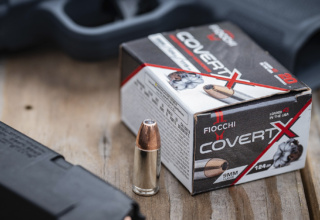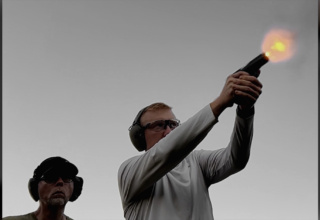When you need a break from serious defensive shooting practice and want to have a bit of fun, it’s time to slap leather and reach for that six-shooter.
by Bob Campbell
When it comes to recreational shooting, just about any firearm will do. If it is accurate enough to strike the target and offers improvement as the shooter builds skills, it is worthwhile. Some like vintage Mausers, others like AR 15 rifles.
I am never happier than when firing a single-action revolver. The closer to the Old West look and style the better. Sure, Blackhawk and Freedom Arms revolvers are masterpieces of the gunmaker’s art, but they are not what Bat Masterson wore. Neither is mine, but it is close enough. The 1873 Single Action Army is a powerful, accurate, and fast-handling revolver. There was nothing like it in its day. The single-action revolver is viable for hunting, protection against wild animals, and even personal defense. It may not be the best choice for some uses, but if you are familiar with the action, it isn’t the worst choice. What you hit with the .45 Colt and the more modern .357 Magnum tends to take notice and stay hit.
It is a thrice-told tale, but the Colt SAA was out of production just before WWII. The fast-draw sport and the popularity of TV westerns brought the SAA back into production. There were a number of clones or copies as well. Some were modernized handguns and others were made to sell as cheaply as possible. Today, Cowboy Action Shooting demands a steady supply of single-action revolvers. There are thousands more revolvers of the type sold than are used in Cowboy Action. Seems we just like cowboy guns. I am pleased to own and fire handguns that have no real purpose save to make me smile. Sure, some potential for utility should be there, but then again, it doesn’t have to be. Traditions revolvers offer the smile factor by the bushel.

A Little History
Originally called the Top Strap revolver, the Peacemaker in civilian sales (and the Model P internally at Colt), and later the Frontier Six Shooter when chambered for the .44-40 WCF cartridge, the Colt SAA was the most rugged, reliable, and powerful cartridge revolver of the day. The grip was little changed from the wonderful feel of the Colt Navy, but the top strap was an improvement similar to the 1855 Colt revolvers and the later 1858 Remington. These new revolvers were of better steel compared to their iron ancestors. The 7 ½-inch barrel .45 Colt revolver was designed to allow a trooper to hit and severely wound an Indian war pony at 100 yards. War is a nasty business, and in most of these battles, more horses than men were killed. Eventually the SAA was chambered for more than thirty calibers.
The 5 ½-inch barrel length was offered later, followed by a 4 ¾-inch version and even a Sheriff’s Model with a shorter barrel. I like them all but the Gunfighter configuration with the barrel cut even with the ejector rod for 4 ¾ inches is my favorite. This revolver clears leather quickly, is easily carried, and has a balance like no other handgun. The Colt is very expensive at over two thousand dollars on average, if you can find one.
A New Breed, Same Classic Lines
A modern alternative with little in the way of compromise is the Pietta-manufactured revolver from Traditions Performance Firearms. It is called the 1873 Frontier.
A significant difference in the modern 1873 revolver is the ignition system. The original SAA features a hammer-mounted firing pin. If carried fully loaded, the firing pin will rest on the primer of a chambered cartridge. The old trick was to load one cartridge, skip a cylinder, then load four and cock and lower the hammer on an empty chamber. This worked well enough when everyone was familiar with the SAA. Today, many use the revolver for recreation or as a sidearm when hiking. Some revolvers are safe with six rounds, some aren’t. A high-production revolver like the Traditions 1873 needed a safer system.
The answer is a transfer bar system. Here, the firing pin is mounted in the frame. The hammer is the typical L-shaped type that is fitted to transfer bar revolvers. When the hammer is at rest, the transfer bar blocks forward movement of the hammer. When the hammer is cocked and the trigger pressed, the transfer bar moves into a position over the firing pin. The hammer strikes the transfer bar which impacts the firing pin, firing the revolver. This is a safe system used in many revolvers. The Traditions Frontier revolver is safe to carry with six cartridges—a fully loaded cylinder. The Traditions single-action revolvers feature among the smoothest trigger actions of the breed.

The latest Traditions in the safe is an 1873 .45 Colt with a 4 ¾-inch barrel. This is a well-balanced revolver. While a swing-out cylinder double-action revolver is more modern, the fairly compact SAA is scarcely larger than a four-inch barrel .38. This makes for a good-packing revolver when enjoying the great outdoors. If recreational shooting is the job description, the 7 ½-inch barrel may be a good choice. They are accurate and the extra weight out front dampens recoil. The 5 ½-inch barrel is a good compromise. The revolver is loaded with the hammer at half cock and the cylinder gate open, indexing each chamber as you load. Always bring the hammer completely to the rear and lower it by pressing the trigger and carefully lowering the hammer with finger pressure. If you lower the hammer from the half cock notch you may cause the bolt stop to rise and scar the cylinder.
Before firing, I dry fired the revolver extensively. I have experience with single-action revolvers, but each trigger action is a case in itself. The hammer drops at 3 ½ pounds and is crisp. When firing this revolver, a certain cadence of fire is needed for best results. It isn’t best to use deliberate slow fire. Bring the revolver to eye level as you cock the hammer and fire as quickly as possible without disturbing the sights. Dwelling on the trigger often upsets the sight picture. The revolver is quite fast on target and as accurate as most modern revolvers. Most of the initial firing was accomplished with the Fiocchi Ammunition 250-grain cowboy load. This is a 750 fps load that’s well-suited to practice and for cowboy action shooting. A hard bullet alloy limits leading the barrel. Results were excellent. The revolver is smooth in operation. It is simple to unload by opening the gate, tipping the barrel upward, and quickly spinning the cylinder. The spent cases just fall out.

Absolute accuracy is always interesting. Moving to handloads, I used the 260-grain Semi-Wadcutter from Mattsbullets.com and with a modest charge of Titegroup powder, I achieved 855 fps in the Traditions revolver. There was more of a push, but the plow-handled grip simply rolls up in recoil. Firing from a standing barricade at a long 25 yards, I placed five rounds into 2.5 inches. The long and heavy SWC bullet has plenty of bearing surface and this makes for excellent accuracy potential. The bullet features a broad, flat nose and efficient cutting shoulder—a formidable combination. The 855 fps is a sweet spot for accuracy in a general-purpose load. Although 950 fps isn’t out of the question, recoil and control become a factor.
For firing quickly, the revolver is grasped tightly. The hand presses hard and high on the grips. The thumb of the firing hand brings the hammer back. As you fire, the revolver recoils. The muzzle rises in recoil and the hammer drives down in recoil. The thumb then grasps and cocks the hammer spur again as the muzzle is brought back on target. Lay the thumb sideways over the hammer, don’t come from the rear of the spur. If necessary, you fire again. Very fast and accurate fire may be done in this manner. The single-action revolver demands a specific cadence of fire and handling. Those who practice will get pretty smart with the piece.

If you don’t handload, Buffalo Bore Ammunition offers a number of hard-cast bullet loads, including a 255-grain SWC at over 900 fps. They also offer a full wadcutter and a lead hollow point—perhaps the most effective .45 Colt load for personal defense. This gets the .45 Colt into a choice territory for defense against animals.
I like the Traditions/Pietta 1873 SAA Frontier very much. My examples have proven smooth and reliable, and while they are built of modern steels, they offer a link with the past. I think Bat Masterson would approve.
A Touch of Class
A space age research company in Italy developed a laser metal engraving process. It wasn’t long before Pietta developed a partnership to produce nicely engraved revolvers at a fair price. It is an interesting study to compare the American Banknote and Bookend engraving styles, but I really don’t know much about it.

I know what I like. The Liberty Model and more recently the Tilghman Model feature engraving on the barrel, ejector, frame, cylinder, and back strap. Hand engraving is very expensive. Laser engraving offers an affordable and tasteful alternative. The Liberty illustrated is chambered for the .357 Magnum cartridge. The .357 Magnum revolver also accepts .38 Special ammunition, making this revolver the most practical for cowboy action shooting. Thirty-eight Special loads are inexpensive to handload and factory ammunition is much less expensive than .45 Colt. Recoil is less as well, but then you have the Magnum option—just in case.

Carrying the SAA
You don’t necessarily need a cowboy rig unless you are competing in Cowboy Action Shooting. For day-to-day use, hiking, and general carry, a master in leather is Rocking K Saddlery. Among my favorites it the Threepersons holster. Invented by lawman Tom Threepersons about one hundred years ago, the Threepersons holster dismissed the heavy skirting of the Mexican Loop holster. The western holster demanded a large gun belt.

Threepersons designed a holster suitable for use with a heavy dress belt under a suit coat. The Threepersons remains one of the most useful and comfortable day-to-day holsters ever designed. Rockingksaddlery.com also offers a unique belt slide for the SAA.



















